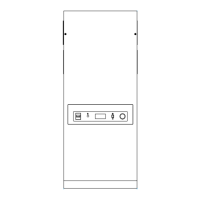
Do you have a question about the Olimpia splendid Ci1 Sries and is the answer not in the manual?
| Brand | Olimpia splendid |
|---|---|
| Model | Ci1 Sries |
| Category | Chiller |
| Language | English |
Overview of the chiller's capabilities, design, performance, and ease of use.
Discusses product durability, quality, user-friendliness, and ease of installation.
Details the unit's construction, compressors, heat exchangers, and fan system.
Explains the integrated safety mechanisms and the electronic control system.
Information on the electrical panel layout and available accessories for unit control.
Lists the relevant European and international standards for product safety and performance.
Detailed dimensional information for Ci5, Ci7, and Ci10 models, including air passage points.
Comprehensive table of technical specifications for cooling capacity, power, efficiency, and components.
Tables detailing performance metrics like refrigerating power and environmental conditions.
Specifies the minimum and maximum operating parameters for the unit.
Coefficients to adjust performance based on temperature variations.
Graphical data showing pump performance characteristics for different models.
Discusses operational principles, advantages, and solutions to installation challenges.
Explains the evaporative cooling technology and its application.
Highlights the ease of indoor installation with minimal external connections.
A labeled diagram showing the arrangement of internal components and fluid paths.
Emphasizes qualified personnel, adherence to guidelines, and general safety advice.
Procedures for managing liquids, lifting, and transporting the unit safely.
Critical safety checks and procedures for installation and initial unit start-up.
Safety protocols for performing maintenance, repairs, and handling components.
Steps for safely dismantling the unit and disposing of oil and refrigerants.
Specifies operations requiring qualified technicians and prohibited uses.
Explains symbols found on the machine, diagrams, and stickers for safe operation.
Details the operating principle and the unit's build, including materials and components.
Describes the unit's casing and the sound-insulated compartment for the compressor.
Information on compressor type, refrigerant, and protective systems.
Details on the high-efficiency plate evaporator and its integration into the tank.
Description of the condenser coil design and its contribution to efficiency.
Information on the fan's operation, head, and flexible air outlet positioning.
Description of the hydraulic unit's components, including tank, pump, and safety devices.
Explains the water circuit's components and flow, including the pressure gauge.
Details the refrigerant path through the system, from compressor to evaporator.
Guidelines for selecting the installation site, considering space, ventilation, and ambient conditions.
Crucial safety instructions and general advice to be followed before commencing installation.
Diagrams showing required air passage for floor-mounted installations.
Diagrams illustrating air passage requirements for wall-mounted installations.
Specific requirements for installing the unit within a niche.
Instructions for preparing the wall for unit mounting, including hydraulic fittings.
Step-by-step guide for connecting water pipes, respecting flow direction and installing taps.
Crucial instruction on installing a water filter to prevent evaporator damage.
Formula and example for determining the correct minimum volume for the expansion vessel.
Recommendations for adding antifreeze based on ambient temperatures and glycol percentages.
Instructions for draining the water circuit to prevent freezing damage during inactivity.
Steps for removing the front panel to access the electrical components.
Guidelines for connecting to the mains, including voltage, frequency, grounding, and protection.
Instructions for setting up remote control via external contacts and switches.
Instructions for mounting the remote terminal and explanation of keypad functions.
Overview of the control console and essential checks before starting the unit.
Description of the automatic plant flushing function to prevent scale buildup.
Wiring diagrams for power supply, main components, and external interfaces.
Explanation of input and output terminal board connections for the pan control.
Overview of the electronic control unit, its interface, and keypad operation.
How to interpret display information, set parameters, and adjust temperature setpoints.
Details on operational hours, alarms, and machine status indicators.
How the unit performs diagnostics and signals alarms, including reset modes.
Comprehensive list of alarms, their codes, descriptions, and operational impact.
A labeled diagram showing the location of all major internal and external parts.
Detailed list of adjustable parameters, their units, limits, and default values.
Guidelines for using the control interface, allowed operations, and user responsibilities.
Essential checks and operations for maintaining proper function and preventing failures.
Blank pages for user notes.